How many coats of primer short answer: all unfinished surfaces like new drywall need one coat of primer: it seals the pores. Repainting a wall? If the color changes are not drastic, no primer is required!
Quick Menu: Primers come in 3 basic flavors: latex—oil—shellac (these clean-up with water—mineral spirits—alcohol). In most cases, apply one coat of primer. All can be sanded for a nice smooth start.
If you just want to see them quickly:
(all these ship for free)
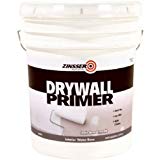 For new (unstained) drywall: One coat of primer. You don’t need stain blocking power, so use this good but inexpensive drywall primer. The image is for 5 gallons, here is the one-gallon.
For new (unstained) drywall: One coat of primer. You don’t need stain blocking power, so use this good but inexpensive drywall primer. The image is for 5 gallons, here is the one-gallon.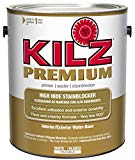 For re-painting walls, trim, etc: One coat of primer unless the new color is the same (or similar): the go-to primer is this medium-power primer. I use this when changing from dark to light colors.
For re-painting walls, trim, etc: One coat of primer unless the new color is the same (or similar): the go-to primer is this medium-power primer. I use this when changing from dark to light colors.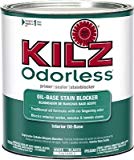 For unpainted wood: One coat of the right primer: (see caution below about latex primer and wood). Use a medium-power oil-based primer for most woods.
For unpainted wood: One coat of the right primer: (see caution below about latex primer and wood). Use a medium-power oil-based primer for most woods.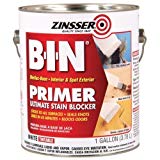 For nasty stains, ink, and worse: One coat of the big dog primer: this high stain blocking shellac-based primer. Have rubbing alcohol ready for clean-up. Ah, Bin, is there anything you can’t do? No Homer.
For nasty stains, ink, and worse: One coat of the big dog primer: this high stain blocking shellac-based primer. Have rubbing alcohol ready for clean-up. Ah, Bin, is there anything you can’t do? No Homer.
Related:
Read all about Best Drywall Primer & 4 Simple Steps for Priming
Our tool post for every basic professional painter’s tools at the best prices we can find
3 Primer Rules:
I was asked to discuss how many coats of primer are needed in interior painting situations, but on the job, the question rarely comes up. Here are the basics.
By the way, actually painting the primer coat can be very fast as it flows better than paint (plus in the end 3 coats is better from a quality point of view). Be sure to read the shortlist of what primer does for you just below this:
- General rule: All unfinished surfaces need a primer. It will save you time and money, and look a whole lot better, but how many coats of primer should you apply? Almost all of the time, you only need one coat of primer if it’s the right one! Not what they told you? Don’t listen to non-painter websites. They hire English majors.
- Tinting? Many primers can be tinted but not much because the tint affects its sealing performance. The paint store sales folks know what not to do. Start slowly if you want to D-I-Y: see below how gray is best for coating with red, etc. Learn about tinting here.
- How long does it take for a primer to dry? Even the oil-based primer listed below dries fast: much faster than oil-based paint. Latex primer takes on average 30 min to 1 hour, and oil-based primer up to 3 hours. How long the primer takes to dry depends on the humidity and temperature of the room (cold and humid longer, obviously). But primer usually dries faster than paint.
- Check the toxicity: if the primer (or paint) does not say ‘zero VOC’ or ‘low-VOC’, I use VOC-free primers and paints or I wear protection: a respirator. The world of filters is mind-boggling, so read this easy post about good quality respirator protection. They are not expensive and I give this as a gift.
Caution: Water-based primers on untreated wood has, can, and will raise wood grain. Why? Tree rings alternate hard/soft and the soft rings grab more paint and expand, and dry that way: a smooth surface becomes bumpy. Oil-based primers are preferred for almost all wood. See below about how to put the right primer on wood.
How Many Coats of Primer:
- How many coats of primer on new drywall? One coat of primer, if you use a quality primer: click on the image you see here or at the top of the page. When the unpainted walls are in bad shape (old, but never painted) I buy the 5-gallons of a ‘high-build’ primer that hides imperfections Benjamin Moore Ultra-Spec (a contractor line): this is 5 gallons but keeps a long time (never let it freeze!)
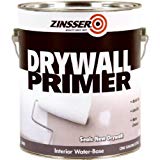
- Going over glossy paint: One coat. Was it last painted with oil or latex? Major huge important. You must find out. The test is below*. Remember: latex paint will NOT STICK to an oil enamel surface. (This is not what oil primers are). If in doubt, you’re safe with Stix. It sticks. New to the world of primer, Stix is my go-to bonding magic. (BTW: You should still sand glossy finishes every time anyway). PS: Stix is made by Benjamin Moore (read about it on BM’s Insl-x website). Alternately: use a de-glosser, then prime with the Kilz Premium just below.
- Walls—changing wall color: One coat. Prime only when making drastic color changes (or when applying reds and yellows). Ask us in the comments or call a paint store about painting over dark colors with light colors or vice versa but yes you need a primer. My main latex primer is Kilz latex primer, a.k.a. Kilz Premium. Tip: reds cover best with gray primer. Yes, gray. Not making a big color change? No primer needed. Can you still use Kilz paint colors with primer? Sure.

- Paint and primer in one? One coat. While it may contain some stain blocking elements, we don’t like it for most applications. Read my post on it. Trying to cover in one coat is slower than two normal coats (you have to keep checking to make sure your coat is thick enough). And we use the same tools you should use. (Crappy tools make you hate painting!) It is also more expensive in the end if you count time as money. We do. Kilz paints are considered to be the best value in this style, and their paint color choices are decent. But paint and primer in one often fails. I would only consider it for low-cost rental units.
- Bathrooms: One coat. Use a primer for high moisture areas: From Benjamin Moore—the famous Auqa-Lock. We don’t use this primer for half-baths—just the main latex primer unless there is a shower stall. How many coats of primer in a bathroom? one coat of primer is enough with a good quality primer.
- Green board drywall: One coat. Greenboard is usually in bathrooms, and while it is probably fine to use normal drywall primer, I recommend an oil-based water primer. It’s worth the extra messy cleanup. Tip: I would buy a brush and roller that I would not clean…sorry about that.
- Painted wood: One coat. Probably doesn’t need a primer (see about glossy trim and see about color changes above). But we do spot prime chips and worn spots with an oil primer for pine which is the most common trim wood, and the one that bleeds the most.
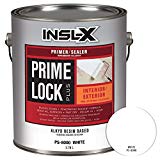
- Unpainted wood: One coat. Yes, always use a primer, and almost never use latex. We use oil primers with disposable brushes. Actually we try to keep the old brush in the can for quick hits later! If you want a smooth finish, fill the wood grain, you need to create a flat surface with a grain filler**. Paint and primer are not designed to fill holes. Oak grain could look fine with a thick coat or two of a coat of a decent oil primer, sanding between coats. In any case, we mainly use this stain-blocking primer: Ben’s Prime Lock Plus.
- Stains: One coat of primer if it has stain blocking power, but it depends on the stain. We have a whole post about putting paint over stain. For water stains etc, all the tough stains, go jump to the shellac (alcohol-based) primer because you know it the problem will disappear. BIN to the rescue. Check you work when dry. Did stains bleed through? A 2nd coat (spot priming) may help. Some bad stains like wood knots can take a year to bleed through lesser primers.
Other less often asked about:
- Floors: One coat. See an entire post just about how to paint floors and another on the types of paint available.
- Mold: One coat. If you just want the right stuff it’s easy, but if you want to read about mold, here is a close look.
- Particleboard: One coat. If you must. Use the same primer as for unpainted wood: Prime Lock Plus.
- Plywood: One coat. Watch a video from a real wood nerd (he’s very smart) about the enormous differences in plywood. Some are cabinet quality. Some for sub-floors. Use the same oil primer as you would wood. Ceiling sealing. Ha ha. Dear deer.
- Masonry: One coat. Easy…masonry primer.
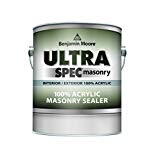 Use a block filler if you want to avoid the institutional look.
Use a block filler if you want to avoid the institutional look. - Metal: One coat. There are metal primers like Rust Scat by Benjamin Moore. You should not paint metal without it. Don’t drop a can on your own driveway like bradthepainter. Oh yes.
- Tile, stone, laminate, etc. Zero. Don’t paint it. Trust me on this. You and I have known each other for a long time.
- Smoke damage, stinky odors: One coat, if you use the big dog of primers. There is a primer for this. Cigarette smoke is notorious. It may take more than one or 2 coats to un-stink it. I have had success with Kilz Restoration: you should wear a respirator for sure.
- Wet anything: Oi vey, don’t paint anything unless it’s bone dry. Try fans, heat etc. If you must paint something when wet, use an oil-based primer and try to work the primer vigorously into the material. Again, not recommended. I have never tried the swimming pool paint, but it may help.
The only time we would ever ponder how many coats of primer to use is when our first product did not contain enough sealants (resins, etc) and some stains from the old surface managed to bleed through. Even so, sometimes, a primer will show stains when it is dry, but it has, in fact, stopped the stain right there: it will not allow the stain to bleed into the finish paint. Easy to test for this. When in doubt, B-I-N is the answer. BIN is the answer.
We had a reader write and ask why the dark areas near her radiator were bleeding through. Answer: Wrong primer. Some primers just seal drywall (and they are not very expensive). Others seal out nasty water stains and magic marker spots. Those are hard to seal, so you have to hit those spots with the nuclear option. Explained next.
The shortlist to know about primer:
- Primer works by filling different size pores in different areas of your surface—not all areas are the same just because they look alike.
- Why not just use old paint as a primer? Because paints are not stain-blockers/pore-sealers. If you prime new drywall with regular paint (never use exterior paint inside), you will always see the taped seams through the topcoats. See the first bullet point above.
- Even skimmed coat walls need a primer to achieve a uniform top-coat look. (Fine with one coat of a good drywall primer.)
- Water-based primers on wood can ruin it. Read the bullet point above about ‘unpainted wood’.
- Primers do not fill holes or grains in the wood.
- Primers apply faster than paint and you don’t need to care how they look so you can go fairly quickly.
* Testing old paint: To re-paint glossy trim you need to know if it was painted with oil-based paint or not. Test it with acetone or in a pinch, rubbing alcohol. Put the solvent on a cloth or paper towel and rub the paint. Does it get gooey? It is latex. No goo, oil. Painting latex over oil: sand like a banshee (scratch every bit to create a bond for new paint), or use the Mother of all Toxic materials, de-glosser. This stuff evaporates like water on a red-hot skillet. Nasty. Wear your respirator!!
** Wood grain fillers really work. There are 2 sizes of the best product going, but if you are doing more than a small piece of furniture, get large to save money. This does not fill large holes. You need wood filler for that.
This is a generic one coat paint of brown semi-gloss rolled onto some primer. The brown looked fine when wet. Now look:
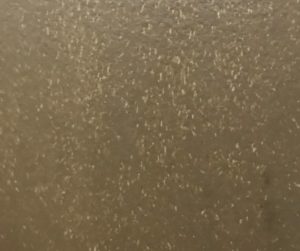
Did we leave anything out? Let us know in the comments!
How many coats of primer on wood? Somehow people got the idea you need more than one coat of primer on wood.
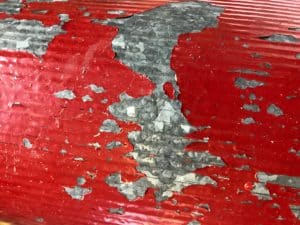
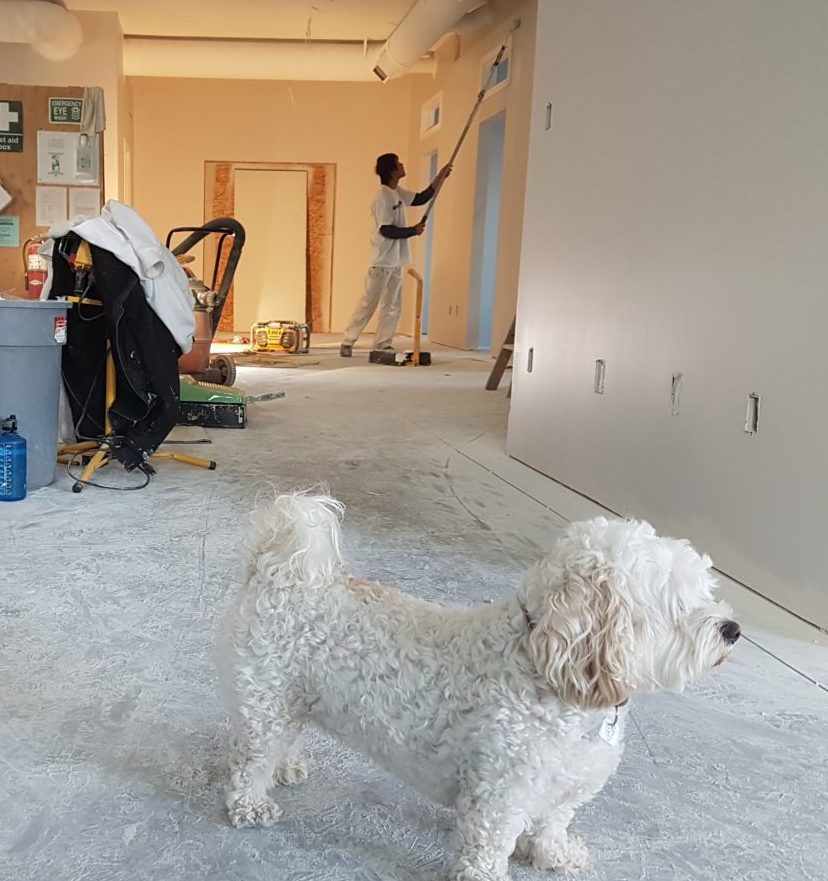
Hi Brad,
We are going a little kitchen make over until we can do a full gut renovation (hopefully in 2 years). The cabinets are original from 1960 and made of Douglas Fir. They are wood toned but I think have been sealed in some way (so not just raw wood). When we have left things in the cabinets in the past, they stink. So I am trying to seal in all the odors before painting the interiors. I started with wiping them down with TSP (which really releases the stink). And have started priming with Kilz Restoration. (My plan is 2 coats primer and probably 2 coats paint). Is Kilz up to the task of sealing out the smell? Also what paint would you recommend for the inside of cabinets? And outside?
Thanks for your help!
Kate
Maybe not. 2 coats of that is not as good as one coat of BIN shellac (alcohol-based, not ‘synthetic’ water-based).
But that is nasty nasty nasty primer. You may be ok, but I’d stop where you are and take a door into another room and see if you can smell the smell thru the primer smell. Also see if its bonding well: scratch with your fingernail. It should not come off and that’s uber-important in cabinets.
I’d recommend Ben Moore Advance, but it’s hard to apply: water-based but runs and drips like oil, but it’s worth the thin coats as it looks amazing.
If not, just glossy hi-quality latex is what most people do.
Thank you! I am going use BIN as the second coat of primer. I read that you shouldn’t use TSP to prep a surface for BIN. Will I be ok since I already covered the TSP prepped surface with Kilz? Or have I created a big mess? Thanks again for your help!
Different room- what type of paint do you recommend for bathroom ceilings?
Should be ok. I have never heard that about TSP and BIN. Can you email me the link where you read that? Interesting.
Baths: not flat like most ceilings. I use the same wall paint, but white. Any bath paint is good but I always fall back on BM Aquaglo.
b
Have south-facing wood exterior windows in New Mexico dry climate. Have reprimed/repainted exterior trim three times in seven years. Did it in June and a short hailstorm in August chipped and stripped lower edges only on windows. Use Kilz as primer and latex Behr as trim color. Do I need two coats of primer before I repaint? Will this help with degradation?
I have an educated guess: is the wood ‘pressure treated wood’? If so you may need to use a grinder/sander to go down to the wood then start over with a bonding primer: and dont’t skimp on the cost primer. My vote would be Stix from Ben Moore but if you are having problems now, who knows if this will bond? Could it be a moisture problem?
I thnk you need to call an OLDer painter and get to the reason why it’s not bonding properly.
Good luck.
Thanks for your input. I failed to mention my house is 35 years old and these are likely the original window frames–perhaps with newer quarter-round trim at the bottom. Grinder on my Dremel should work, so that’s what I’ll do. Thank you.
We are priming all the walls in preparation for selling the house. We will allow a paint credit to the new buyers but want to repair holes and cover 20 years of living.
Can we use a sprayer to apply the primer or do we need to roll?
Thanks
The short answer is you can roll or spray. It doesn’t really matter. The one thing that matters is how much you have to do. If it’s one or two rooms I would probably roll it. If it was a whole house sprayer it’s going to save a lot of time. Good luck
Yet another question…
I removed wood paneling that had been nailed over drywall. I skim coated about half of one wall to repair some damage, and filled in cracks and nail holes with mud. What kind of primer is best in this case?
If you have no stains, like water stain, just drywall primer. If in doubt ratchet it up a notch and get some stain-blocking primer.
I’m building a miniature sleigh as an outdoor decoration with 3/4 red oak plywood. It will be outside on Long Island from mid November to mid January. I’m not worried about raised wood grain but I do want to minimize warping. Can I use latex primer or must it be oil? Any recommendations?
For longevity, oil for sure. It will get you thru a few years. Lay on your final coat in many coats to keep the water from getting in and you’ll be set.
Good luck.
I’m painting a room at the moment. This time I did 3 coats of primer on everything. I even re-primed the new pre-primed trim from Home Depot. In my house I have rooms that I did not prime, rooms that I primed with one coat, rooms that I primed with two coats etc.
Definitely doing 3 coats of primer has yielded the best results.
I was wondering … you are saying that most often one coat of primer is needed … Have you ever tried painting with two or three coats of primer?
Well, you will certainly get brighter as you add white, but for sealing and bonding, one coat is almost always enough.
I am happy you are happy, but I think you could have saved money… used it for more paint! Thanks
Hi Brad! I’m digesting ALL of your content and tips right now. Decided to bite there bullet and paint my whole condo. It was painted by the remodel people who fixed it up to sell before I bought two years ago. However, many spots when knicked begin peeling and I’ve got peely spots in many places. I just did your acetone test and the paint goes gooey and completely removes on the walls and trim, exposing the once yellow walls beneath. I am thinking they painted latex over oil sloppily and that’s why it peels? Can I get away with Benjamin Moore without using a primer or will I need to prime? Do you recommend a certain line of BM also? I have a very light gray on the walls but using the paint samples of simply white and white dove look great but took 3 coats on each swatch just to get it covered. I’m hoping that’s just because of the quality of the little sample cans though.
First, on the gray walls, 3 coats is not surprising. BM should cover in 2, but it depends on the line of paint. Less expensive ones have less solids in the solution and therfore do not cover as well. I’d put a dryall primer, any white, for my first coat just to save a bit of money. It adds up. Two coats of Ben or Aura would have done it. In fact maybe one of Aura, but that’s pushing it.
On your main question, I am assuming it’s trim. Often painters don’t prep.
I want you to go back to your test spot, scrape off all the latex covering the underneath coat and do your acetone/alcohol test on THAT.
If that does not get goey…your old painters did not prep the oil paint and you have a big, big problem.
If this is the case, and I would give great odds it is, you need to sand/scrape off all the latex. Are you sitting down? I should have asked you that first!
But hold on, it’s not all bad.
You see, you only bump your trim at humnan-level. It’s unlikely you’ll scratch off the paint above a door, on the frame, right?
So don’t remove that, just paint over it. Yes, it’s wrong.
To do it right, remove it all.
Then, you must sand all that oil or use a liquid de-glosser. Read more on that here.
Then, use a good BONDING PRIMER like Stix from BM but there are many. I like Stix.
You need this, but you must prep also.
Best wishes. Remember, it’s a condo, so you won’t be there forever!
Oh man! Thank you for the wealth of information! You are right, I’m not going to live here to forever. Honestly, I think I may put all the effort in on the doors and trim but not on the walls. I’m a single person, no kids, no dogs, I just can’t see that time investment being worth it for this. For the walls should I go with drywall primer or the Stix? And then one or two coats of Aura. I’m planning on buying the 18” roller with the rod and bucket to make the project easier on myself.
If it takes 3 coats, just get the lowest cost first coat you can. Whether that is a primer or not, the topcoats cost the most.
My point is that it’s just for coverage, and you do not need primer qualities like stain-blocking etc. Hope that makes sense.
Aura is very expensive and may cover in 2, so less work, but about the same money. Caution with Aura is that is very thick and you need to have some skill.
I’d stick to Ben.
Stix was just for the trim or where you have oil. Walls are not oil I assume.
The big 18 is a lot. I’d recommend the 9. Get the 50-50 wool poly roller covers on my tool page. They last. Also see my post on how to clean them very easily.
Thank you so much! This was so helpful. I will definitely purchase through your page. By the way, acetone test ended up taking me through at least 4 layers of paint. So I’m thinking my problem may just be that there are way too many layers on the walls. I’m about to seal them in again!!!
Hi, I have a painter who finished skim coating old walls in my apartment. He put on one coat of primer on but I still see imperfections and I’m going to ask him to fix these. Once he does does, does he need to prime the whole wall again or just the areas he’s fixed. I’m using BM white in eggshell sheen as my final pant color. Thanks for any advice!
No, he just needs to sand the spackle spots, then prime them.
I assume you have no stains and the primer is just for drywall, then you’re ok. Stains will bleed through many layers so we used stain blocking primer.
So I’m saying if you had stains BEFORE the skimming, you will have stains again if they were not blocked. Just thinking ahead.
Good luck!
Hello-
I am painting a wall in a 3 season room/sunroom type space. The sunroom was added after the house was built so the back wall is exterior aluminum siding, and this is the wall I am painting. Since it is siding and not flat, I have to use a brush instead of a roller, and I’ve applied one coat of primer but it’s kind of streaky and not opaque. I’m wondering if it is worth doing a second coat of primer or if I can just go ahead and paint. I used Kilz 2 interior/exterior water based primer. The aluminum siding had some stains and it had been painted with an exterior paint many years ago. The new color we are doing is slightly darker and much more vibrant than the old color. Thanks!
Hi. If there is not metal (requires metal primer) showing, and it has latex, you are all set to paint. If you have skips in the primer, make sure they cover the old paint (at least a film).
So no, a 2nd coat of primer not really necessary but would not hurt.
Two things:
you said you can’t use a roller, but that is not true: you can roll and then brush right behind it. It’s way faster than just brushing.
2nd is that if this space will freeze do not use interior paint.
Exterior paint is softer and moves with temp, but interior paint will crack!
What a mess interior paint is outdoors. Then you’ll have to write me all over again, and yada yada.
Good luck!
Brad
Looking to paint the textured walls in our new house that have glossy latex paint on them. Sanding would be uneven at best because of the texture. Do we need to use a high bonding primer or would a regular one work? Given household sensitivities, we would prefer a zero VOC primer, which does not seem to be an option for high adhesion primers.
Thanks!
You are in luck. This is one of the easiest questions in all my years. You don’t need primer unless you will change colors dramatically. I mean it never hurts, but two coats of paint is going to be fine: this is assuming you are correct in that you have LATEX. If not, and if it’s a glossy oil, and you don’t prime, it’s going to be a disaster.
So for latex on latex, just dust and cut and roll. I’d go with a longer nap roller here depending on the roughness of the texture. maybe 3/4 inch. Get the wool/poly roller on my tools page. VOC free primer
Good luck!
Hi, Was wondering when painting honey oak cabinets if I should use two coats of BIN, or if I could use one coat of BIN and one of the Zinsser 123? Or is there a better primer to use? Thanks for any advice!
One coat should be enough. I don’t know that oak, but if there is resin that can bleed thru, maybe two coats is a good idea…you can never go backwards.
Always test is my rule, but sometimes resins take a year or more to bleed thru. So go with great top coat paint. I like Advance. See my post on trim paint.
Hi, I am repainting interior walls, and started priming with Killz 2 All-Purpose primer. I’m covering gray walls, and the white primer is going on VERY streaky, barely covering the gray. My final paint color is a yellow-tinted white. Do I need two primer coats to better cover the gray? Thanks for your help!
Hi. I don’t think you have a problem. But go ahead and ROLL not brush some top coat and you’ll know. Do 2 coats.
Good luck
b
Thank you for sharing this informative article
HI, do you have any tips on what primer to use prior to interior limewash application? Will any 100% acrylic work or should a bonding primer be used.
Additionally, how can you tell when its had enough coverage for the lime wash to stick? Should no underlying color show through?
Hi. Sorry, I have no experience with lime wash. I need to do an article on it..or find someone with experience. Look around, esp. at Hunker..they do good research.
Good luck,
B
Hi Brad,
I’m about to repaint the exteriors of a couple cabins in the desert which as you know experiences hot sun for 6 months out of the year and occasionally very strong winds. Once cabin exterior is wooden siding and the other one is stucco. I’m a little paranoid about dry rot so I used to apply two coats of Zinsser Peel Stop before painting desert cabins in the past, which I’m sure was overkill. If I prime with a single coat of Kilz 2, it will save me a lot of money and time. Will this suffice?
I think so, yes. But I can’t see the wood, so don’t hold me to it!
I would think any oil-based primer would be best. If the wood is pine (SPF) then especially so use oil primer.
For the stucco, not so important. But a harsh environment does call for the best product, so it’s probably less expensive in the long run to spend it now and not have to repeat too soon.
Use the best topcoat you can afford and at least two coats or more.
Good luck,
Brad
I’m painting over OLD wallpaper. I’m pretty sure it was applied directly to the drywall at least 30 years ago. It’s not peeling anywhere and I don’t think there’s any danger of it ever doing so. It’s perfectly flat, no texture and it’s a light color. We’ve fixed the seams and are now ready to paint. I assume we need to use a primer – if so, what do you recommend? Does it have to be oil-based, as I’ve been reading (on other sites)? I have just a regular Zinsser primer that I’ve been using in other rooms. Is that okay?
Well, since you have made the decision, I can’t talk you out of it…but it’s a headache for the future.
For a primer, I’d go with drywall primer unless you have stains. You could spot prime stians if any. But the Zinsser is going to be fine…use the water-based, not oil or alcohol-based
Hope that helps.
Hi Brad
8 months ago I primed an interior door previously varnished with a latex primer. Finally I am ready to paint over the primer but it easily scrapes off. Do I have to sand all the primer off so I can reprime the door or just reprime the door?
Yes, sorry to say. I think your primer could not bond with your old door. An electric sander may help… Once it’s off, SAND the old surface and used a good bonding primer: like STIX.
Then you will be able to forget all this nasty business forever!
Brad, I’m rehabbing a mobile home that renters trashed and then it sat empty for a year. There is mildew on the walls but so far not on the ceilings. Where holes were punched in the walls, we can see they are drywall (or look like drywall). I don’t know what the ceilings are made of. They are lightly textured.
Areas under windows where renters had AC units or left open to the rain are bubbled up and covered in a dark something that may be mold. I plan to remove and replace drywall there but these areas may account for the moisture causing mildew all over. It’s also been rainy and the land slopes towards the mobile home. It’s probably damp under the trailer.
That said, I want to paint the ceilings with a paint that resists mold and mildew. What is the easiest to apply paint (doesn’t drip and takes only one coat) that you recommend for this?
Listen, I usually give advice on how you can do all sorts of painting yourself, and yes, you probably can do much of this yourself…but please! take this advice. Hire a pro to do the prep. Find an OLD guy or gal who has seen it all. Not some young buck..they just don’t give good advice. In the very least case, bring at least 3 painters over and talk it through: what exactly is the procedure? How do you do this? That? Pick brains. Then decide if you can do it yourself. If you don’t get that mold out now, it will be there forever. You may need to rip out all that drywall…probably so. It may be moldy inside. Ick. But do it now and bite on a bullet when you pay the bill. Better not to have many many problems later! That’s hard advice I know but it comes from the heart!!! Good luck,
B
Hi, Painting many 70 year old interior double hung windows with lots of wood muttons (8 over 8 windows!). Hasn’t been painted in at least 10 years; assume it is oil paint (flaking in select areas with some to bare wood especially on the lower sash where the glass meets the muttons) and some of the muttons and exterior trim look fine. Fairly glossy. I’m trying to minimize sanding due to likely very old lead paint. Would like to use Regal Select pearl dove white as top coat and current color is white. I have some Stix and Ben Moore 024 oil primer and fine buying others if a better choice. Should I use 024 on the bare wood areas, Stix on the somewhat glossy areas, 024 on everything, or something else? Is there any advantage/disadvantage to using BM 046 acrylic primer vs Stix on the painted surfaces? Also should I use a liquid deglosser instead of sandpaper? Finally, is it important to lightly sand after the primer and after the first lates topcoat? Thanks so much!
In reverse order, yes I sand between primer and top coats to knock off little particles.
I’m assuming the other questions are exterior. For interior sides, you could use the same primer I’ll recommend for the exterior sides: Prime Lock Plus.
But you must sand or de-gloss.
If you have lead, read this and consider Lead Block. In any case, use the best respirator you can find, not just some mask.
ARe you sure it’s lead? There is a test here.
Normally I’d say STix and the others you mentioned are great, but if you have lead, go Primelock and Lead Block.
Better yet, strip it all!
GOod luck,
b
Painting after wallpaper is removed is just like any other wall. THe key thing you need to do is wipe several times after the paper is visibly off. The glue is sticky, obviously, it’s glue. If you think you are done, mist the wall in a few test areas and run your hand over it. Any stickiness at all? No? Paint away. In most cases, I’d start with a good bonding primer like Kilz Premium or the same Prime Lock I’ll mention below.
I would guess the mobile home walls are thin sheets of wood? Or fake wood? IN any case, you need to make sure it does not flake off whatever the top coating is so use Prime Lock from Ben Moore. Link is here.
Good luck!
b
My doors and moldings were painted by the previous condo owner with oil-based paint. I want to use latex paint. Must I first use oil-based primer over the old oil-based paint before I can paint over with water-based/latex paint?
Hi. Not necessarily. No matter what primer you must first sand all the surface to allow bonding…’bite’ for the primer, then paint with your choice of top coats, usually 2, making 3 altogether. Look at this site about trim paint to see how we use a 9-inch roller to go very very fast. Just don’t use a dollarstore roller they shed lint right away. The brush and 3/8 inch roller cover on this page are what we use. Good luck!
Brad, You’ve solve the debate between my husband and me and saved us a lot of time—I don’t mean to boast, but I was right. 🙂
Really enjoy your style of writing, thanks for sharing your expertise!
Brad – Thanks a ton, good info – much appreciated. We’re at month 4, so we’ll definitely wait it out a bit longer. I totally agree with you, something doesn’t add up! The painter left behind several cans of the products he used. I did a test and bought new sheet rock, primed it, let it dry, then painted it using the paint and primer he left behind. No odor at all. The smell is like a sweet chemical smell.
Thanks again!
I’d love your input on an issue regarding a strange issue with primer. We had a room repainted four months ago. The painters used BIN Shellac on the doors, casing and trim since he believed it was oil before. Then he painted over that. The walls were all primed using a “Gripper” product. Immediately after he was done with the priming (did it all in a few hours), the room wreaked. And… ever since then, if the door and window are closed it has a chemical like odor that lingers. We can’t figure it out. We primed over it and painted again and we’re praying that does something. Otherwise… we’ll have to rip out the sheetrock. The walls, doors… everything smells if you put your nose to it. Wonder if he still had Bin Shellac in his sprayer before he did some of the other work? We’re trying to figure out how to seal the smell and get it to go away.
Hello. Well, this is a rare problem. If he sprayed the Bin, there could have been a little clinging to the inside of the hose, but that would be a small amount … probably not your problem. I mostly use STIX from Ben Moore, never used Gripper. It’s water-based, so probably not your problem.
Here is my guess, and the bad news. You want the bad news first right? He may be lying to you. I cannot understand why these products, if he used them, would smell this long. Here is what I know some painters do: they will tell the customer that they are using a good product like Ben or S.Willimas, etc, then buy crap from some crappy store and fill the empty Ben or SW cans with it. They arrive on the site with the bad paint in good cans. I have no idea that this happened, just saying it has. I heard this from paint store folks.
Here is the good news. Just wait. It will off-gas over the coming months and will go away.
Here is what he should have done: not ‘believed’ it was oil. he should have BLEEPING tested it. Hello? Earth to painters.
To test if old paint is oil or latex is here. He should know this.
No, don’t rip out walls. Just be patient.
If this is not enough info, write again. What does it smell like? Can you remove a sample and apply the test above? Did he leave you any cans? Put some on, let dry and do the test in that post.
Good luck,
Brad
ps, maybe speak with a lawyer if the problem is not rectified in a few months. Invite the lawyer to come see.
Hi, I’ in the process of spackling holes in the wall (left behind from removing several hollow wall anchors) and when I removed 2 of the anchors, the brown drywall paper became exposed. I know that I need to seal the drywall paper before spackling these two holes; what would you say is the best drywall sealer to use in this situation?
Also if you have any other tips regarding this specific problem, they would be much appreciated.
Thank you!
Just the basic drywall primer is fine. Push in any convex bulge in the rock/paper. Use the butt end of your scraper and make it concave, so your spackle will leave a flat surface…otherwise, you get a bump. Any paper sticking up can be sanded AFTER you hit it with primer.. not before… you probably figured that out!
good luck!!
b
Hi,
I am getting ready to paint over a orangey-red wall. You recommend a gray tinted primer. I am planning on buying Kilz Premium primer online (I have Amazon gift cards 😉 What is the best way to get it tinted gray? I’m planning on getting my paint at a Benjamin Moore store – will they do it for me? A big box store? Do it on my own somehow?
Thanks,
Stephanie
Hi. Yes, that primer is great for that. Take it to a paint store: you might get a charge. If you buy some other paint, they SHOULD offer to do it for free. Tell them a painter told you this. Don’t bother with big boxes: HD etc. Good luck! Tip: get a good brush… see my tools page and get Purdy latex only and a wool/poly blend roller. Key point!
I am making a utility box cover with a birdhouse on top. I’m using treated pine and believe I should use Zinsser stain block oil based primer on both the exposed parts and the unexposed parts (inside the box), but two coats of latex paint on only the exposed parts. Will this be a good process?
Hi. If it’s outside all year, put primer plus 2 latex everywhere. Things get wet and the primer will degrade but very slowly. Why not do it all the way before you assemble? If you cut some ends after priming etc then assemble you won’t have 100% but still it will be way better if the inside is coated. Don’t worry about looks and use up some old exterior if you have it. Save your good paint. Don’t use the interior, it will crack when freezing.Good luck. Good choice on primer btw.
b
I love your article, very helpful! In here u have mentioned sanding the primer, is this necessary if I am painting over stained(but lightly sanded down) kitchen cabinets? And also what grit of sandpaper should I use? Then do I wash or tack cloth them again before painting?
Thank you!
Yes indeed. I don’t know what the wood/finish is now, but if wood or paint (not laminate) sand with 220 or 200 and get every square mm. Then wipe with damp cloth or tack cloth a couple of times. You should get no dust on your finger after the wipe down is dry. Then you are all set. Have a look at the article about trim paint: I love the Advance from ben moore. Practice first with it, then you will see the magic: no brush strokes witha water-based paint. Cool.
Hi, Brad! Thanks for providing such an informative posting! I have a drywall ceiling that was painted with McCormick Match Point Interior Latex Flat Wall Paint (14012 Designer White). Some roof leakage caused water stains to appear on the drywall ceiling so I used KILZ Premium primer/sealer/stainblocker on the spots where there were water stains. I did have to apply more than one coat of KILZ to completely eliminate the appearance of the water stains. I waited a day before painting over the KILZ Premium using the same McCormick Match Point Interior Latex Flat Wall Paint (14012 Designer White). It’s been a few weeks since I did all of this and the areas that I attempted to fix are noticeably different in appearance than the rest of the ceiling, especially when the sunlight hits the ceiling.
1. Do you have any idea where I went wrong?
2. Are there any steps that I can take so that the treated areas are not noticeably different in appearance?
I can provide a photo if that will help. Thank you so very much in advance for helping us internet DIY’ers become Picassos!
Hi. I don’t think you did anything wrong. first, the stain blocker sometimes shows some stain in the primer, but it is sealed even though it turns a bit brown. You probably did not need multiple coats, but no harm was done. Great that you have to original paint, but your problem is that (this is my best guess) that the old paint had faded. This is why I use the Ben Moore Ceiling paint: very good coverage in once coat and holds it’s whiteness. Tell that to Bob Dylan and he’ll have to write you a song. Anyway, yes a photo will help somewhat and I can post for others to see, but my advice is to repaint with a new ceiling paint, or if you still have a lot of your paint, do the entire ceiling. That will be fine. Then, don’t look up! PS, watch that movie with Ed Harris about Pollack: he hated Picasso! I love them both!
I have used BIN shellac primer on previously varathaned knotty pine and I love the cottage/ farmhouse look it has now! Do I have to paint a topcoat (of latex paint) or can I leave it as is? It has a whitewashed look to it as I applied the primer with a brush. I’d like to leave as is.
Thanks
Yes, I know that look. Well, you could of course if you like it, but just know that it will take a beating: handprints cannot be washed etc. But when that time comes that you don’t like it anymore, you just paint. I don’t think there is a time limit (many primers have a min.and max time before paint should go on…this is for bonding reasons). If it does, in a few years, you can sand only and touch up primer on places it’s been scraped off, if you like…or re-prime then paint. Next primer would not need to be so extreme… just Kilz Original or such. Enjoy!
Oops, meant to ask separately, not reply to another comment.
We are about to paint 2 bedrooms, both currently painted white. One will be a gray color, the other a sky blue. In the room that’s going to be gray, there was a test area that was painted red, and in the room that’s going to be sky blue, there was a slightly darker blue that was tested. Can we just put primer over the test areas? Or do we need to prime the whole wall/room to get things looking even? Thanks for your help.
Same reply! You’ll do 2 coats so just spot prime should be fine. If you think you’ll try of one coat, you may see a difference between spot primed spot and the rest, so in either case you’ll be rolling 2x. I’ll reply to the other comment there. Good luck!
Brad,
I have wood (fir) outdoor steps that primed and painted 1.5 years ago. They have partial sun exposure. All of the paint (Royal Porch & Floor) has peeled. I’m in the process of repainting and have primed with a heavy coat of Zinsser BullsEye 123. Should I use the Royal again or is there something better (I only need 1 qt)? Thank you.
Hi. I cannot remember if 123 is for exterior, but if it is, yes, go for it. I would use Benjamin Moores Block Out an oil-based exterior only primer. But the main point is that the prep really determines how long the job will last: you should not be out there in less than 5 years, unless you have very high traffic and intense sun, snow, etc.
Scrape the loose paint very well: on our site is info on how and why and on the scrapers and how to file them ( a video of me sharpening) .. Just search for ‘scraper’ and you’ll find it.
The paint for me would be Ben Moore’s Tough Shield or Sherwin Williams product, which I use less often so I do not know the name. Key point: remove loose paint, create bonding with primer and use the best deck paint you can afford. Good luck, b
We used Zinsser Cover Stain primer on the exterior of our home which has previously had multiple coats of an oil-based stain. The primer was allowed to dry for 30 minutes to 1 hour as stated on the can. We then applied a latex paint. The paint and primer have set for 5 days but the paint can be scratched off to reveal the primer underneath. The primer seems to be adhering well to the siding. The humidity has been high in our area during this time frame. Could it be that it will just take longer to cure or did something go wrong? Any advice you can give would be appreciated.
Oh boy, sorry to hear this. I will write to Rust-oleam the makers of Zinsser and ask for you…I may have more power since I help them and ask nothing in return. Yes, do wait a while and keep checking in various areas.
What paint exactly did you put on? The problem is more likely with that.
An interesting test: take a blow dryer and really heat up a few square inches, let rest, cool, then test adhesion. I’m with you.
–brad
The paint is Valspar Duramax High Hiding Paint and Primer with all weather adhesion. It is supposed to be a highly rated paint. I’ll try the blow dryer test and see what happens. Thanks for your help.
Thanks for your excellent and helpful article!
If you use an oil-based primer on softwoods can you then use a latex paint over the oil based primer?
Thanks!
Yes indeed, if the oil-based substance is a real ‘primer’. If it were an oil-based ‘paint’ then the answer would be a big no! Good luck.
Hello. I can really use your advice. I’m painting new beadboard walls. The board will be in two bathrooms and 2 bedrooms. My plan is to paint the beadboard with Kilz premium high hide stain blocking primer. My questions are:
1. Do I need to prime both sides of the beadboard?
2. After I prime the panels do I then caulk the seams and nail holes?
3. Is it ok to have the printer tinted? I am planning to paint the same color with latex over the primer.
Thank you for your help.
Sincerely
Hi. No, and yes, and yes.
The beadboard I know of is already primed at Home Depot etc, but if it is not, yes you really must and the primer you mentioned is excellent. Both sides? Not necessary unless you have leftover primer and nothing to do with it, then sure, why not? Cannot hurt, especially in a moist environment.
Yes, caulk after primer.
Tinting is ok, but if you do it yourself, be careful. Paint stores know how much tint can be added without affecting the property of the primer: too much and you lose your sealant properties… not so good. BTW, paint and primer in one: I’m not a fan. Better to be sure. Cannot trust advertising.
If you want to DIY, search for ‘tint’ on this site. Grays cover so well–almost always the best
So plan on primer plus 2 top coats. Get the brush and roller set up I often point to: lasts a lifetime for a homeowner and you’ll go fast, neat, and not dread painting next time.
Hope this helps. If not, let me know.
Brad
We are about to paint 2 bedrooms, both currently painted white. One will be a gray color, the other a sky blue. In the room that’s going to be gray, there was a test area that was painted red, and in the room that’s going to be sky blue, there was a slightly darker blue that was tested. Can we just put primer over the test areas? Or do we need to prime the whole wall/room to get things looking even? Thanks for your help.
You’ll do 2 coats so just spot prime should be fine. If you think you’ll try of one coat, you may see a difference between spot primed spot and the rest, so in either case you’ll be rolling 2x. I’ll reply to the other comment there. Good luck!